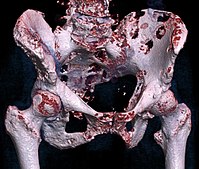
Photo from wikipedia
Abstract. Bone metastases are a frequent occurrence with cancer, and early detection can guide the patient’s treatment regimen. Metastatic bone disease can present in density extremes as sclerotic (high density)… Click to show full abstract
Abstract. Bone metastases are a frequent occurrence with cancer, and early detection can guide the patient’s treatment regimen. Metastatic bone disease can present in density extremes as sclerotic (high density) and lytic (low density) or in a continuum with an admixture of both sclerotic and lytic components. We design a framework to detect and characterize the varying spectrum of presentation of spine metastasis on positron emission tomography/computed tomography (PET/CT) data. A technique is proposed to synthesize CT and PET images to enhance the lesion appearance for computer detection. A combination of watershed, graph cut, and level set algorithms is first run to obtain the initial detections. Detections are then sent to multiple classifiers for sclerotic, lytic, and mixed lesions. The system was tested on 44 cases with 225 sclerotic, 139 lytic, and 92 mixed lesions. The results showed that sensitivity (false positive per patient) was 0.81 (2.1), 0.81 (1.3), and 0.76 (2.1) for sclerotic, lytic, and mixed lesions, respectively. It also demonstrates that using PET/CT data significantly improves the computer aided detection performance over using CT alone.
Journal Title: Journal of Medical Imaging
Year Published: 2017
Link to full text (if available)
Share on Social Media: Sign Up to like & get
recommendations!